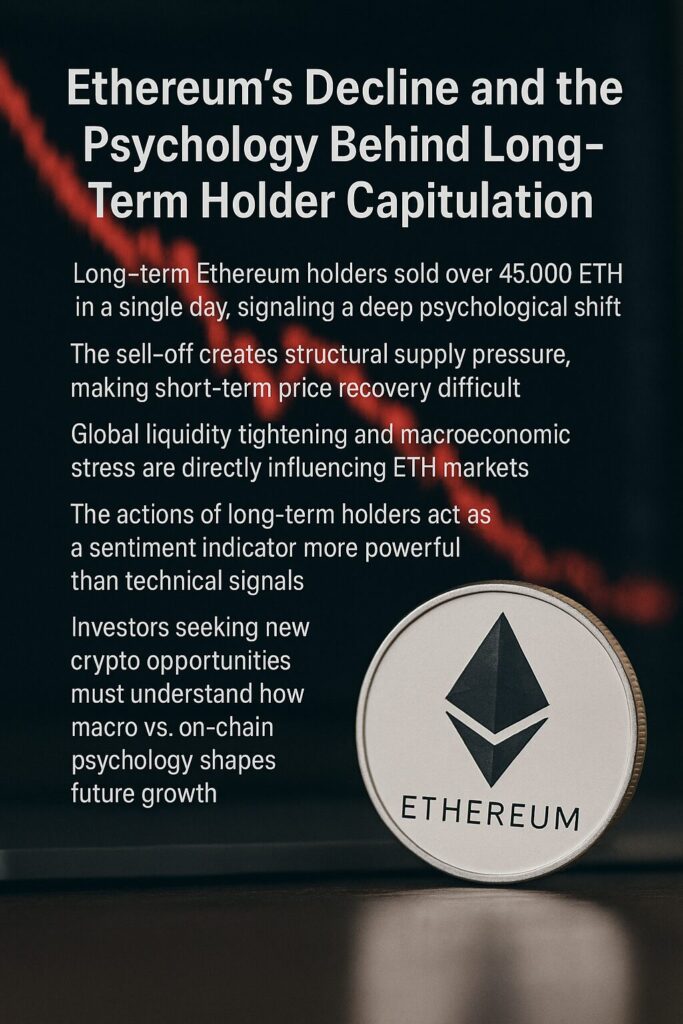
Main Points :
- Long-term Ethereum holders sold over 45,000 ETH in a single day, signaling a deep psychological shift.
- The sell-off creates structural supply pressure, making short-term price recovery difficult.
- Global liquidity tightening and macroeconomic stress are directly influencing ETH markets.
- The actions of long-term holders act as a sentiment indicator more powerful than technical signals.
- Investors seeking new crypto opportunities must understand how macro vs. on-chain psychology shapes future growth.

1. Long-Term Holders and the Psychology of “Escape Behavior”
Recent Ethereum declines have revealed a striking behavioral shift among long-term holders—investors typically regarded as the most resilient and conviction-driven participants in the crypto ecosystem. The sale of over 45,000 ETH in a single day is not merely a technical event; it represents a critical psychological pivot.
Long-term holders (“HODLers”) are known for ignoring short-term volatility because they anchor their decisions to Ethereum’s fundamental value—network growth, decentralization, expanding use cases, and the broader vision of decentralized finance. For that reason, when these investors begin selling, the market interprets it not as profit-taking but as fear of deeper structural or macroeconomic risk.
Their exit suggests that current risks are perceived not as temporary noise but as systemic threats. These threats include the tightening of global liquidity, growing regulatory scrutiny over DeFi markets, and macroeconomic uncertainty. The decision to sell, therefore, signals a protective instinct—an “escape behavior” driven not by short-term sentiment but by a fundamental reassessment of risk.
This makes long-term holder activity a psychological barometer for market depth, trust, and future expectations. In many cases, such behavioral shifts precede major market bottoms or extended periods of sideways consolidation.
2. Concentrated Supply Pressure and the Structural Challenges of Recovery
When more than 45,000 ETH enters the market within 24 hours, supply pressure spikes immediately. Unlike short-term trader activity, large holder sell-offs require substantial new capital inflows to absorb the liquidity without causing sharp declines.
This is especially challenging under the current conditions:
(1) New buyers are cautious.
Risk-off sentiment across global markets has led to slower inflows into crypto assets. Investors prefer cash, stablecoins, or yield-generating traditional products during uncertain periods.
(2) Regulatory concerns limit DeFi participation.
DeFi borrowing, liquidity provision, and staking—normally strong sources of demand—have weakened due to uncertainty surrounding regional regulations, especially those targeting leverage or yield services.
(3) The negative sentiment creates a feedback loop.
The large sell-off by long-term holders reinforces fear among retail and short-term traders. This can lead to further selling pressure, creating what analysts describe as a negative reflexive cycle.
The combination of these elements creates a structural obstacle for short-term recovery: it is not enough for ETH to stabilize; it needs new, confident capital willing to buy aggressively at lower prices. Historically, such capital only emerges after macroeconomic clarity improves.
3. Global Liquidity Tightening and ETH’s Increasing Correlation With Macro Trends
Ethereum no longer trades independently of global economic conditions. As the backbone of the DeFi ecosystem and a major liquidity hub for stablecoins, ETH’s price has become tightly correlated with:
- global liquidity cycles
- interest rate directions
- quantitative tightening (QT)
- institutional risk appetite
Central banks worldwide are removing liquidity from markets—a sharp contrast to the 2020–2021 period that fueled explosive crypto growth. When liquidity is abundant, risk assets flourish. When liquidity contracts, the first assets to suffer are those associated with high volatility and uncertainty—including cryptocurrencies.
Ethereum’s decline and long-term holder capitulation reflect this new structural reality. As DeFi expands and tokenized assets continue to integrate with traditional finance, Ethereum becomes increasingly sensitive to macro stress.
In other words, the sell-off is not a verdict on Ethereum’s technology, roadmap, or long-term potential. Instead, it signals that macro beats fundamentals when liquidity dries up.
4. What This Means for Investors Seeking New Crypto Opportunities
For readers searching for emerging crypto assets, new income sources, and practical blockchain applications, these market dynamics provide several key insights:
(1) Long-term holder psychology is more predictive than price charts.
Their behavior reveals deep risk perception—not noise.
(2) Liquidity cycles now dominate crypto performance.
New projects with strong fundamentals still depend on global liquidity availability for growth.
(3) Ethereum’s sell-off may create opportunities in:
- Liquid staking derivatives (LSDs)
- L2 scalability solutions
- Yield-generating real-world asset protocols (RWAs)
- High-utility tokens used in payments, remittances, and compliance-aligned ecosystems
(4) Diversification into low-correlation assets becomes more valuable.
Utility tokens used within actual financial applications—in remittances, payments, or cross-border settlement—tend to be less sensitive to macro cycles compared to pure speculative assets.
5. Conclusion: The Signals Beneath the Decline
The Ethereum market is undergoing more than a price correction. It is experiencing:
- a shift in psychological confidence
- tightening global liquidity
- regulatory unease in DeFi
- structural supply pressure
The sell-off by long-term holders serves as a rare and powerful indicator. It signals that even the most committed investors are preparing for extended uncertainty.
However, for strategic investors, this phase offers clarity. Times of heightened fear often reveal:
- undervalued assets
- new real-utility protocols
- and sustainable long-term opportunities
Understanding the psychological and macroeconomic forces behind today’s decline gives investors a better foundation for identifying tomorrow’s growth sectors.

